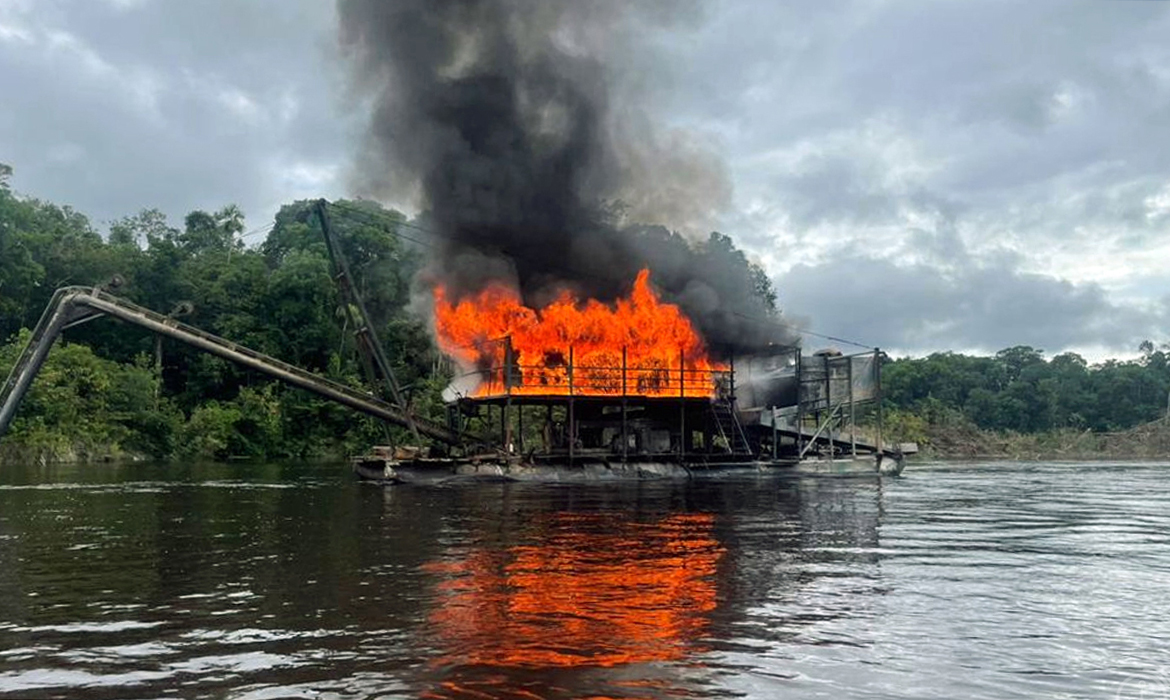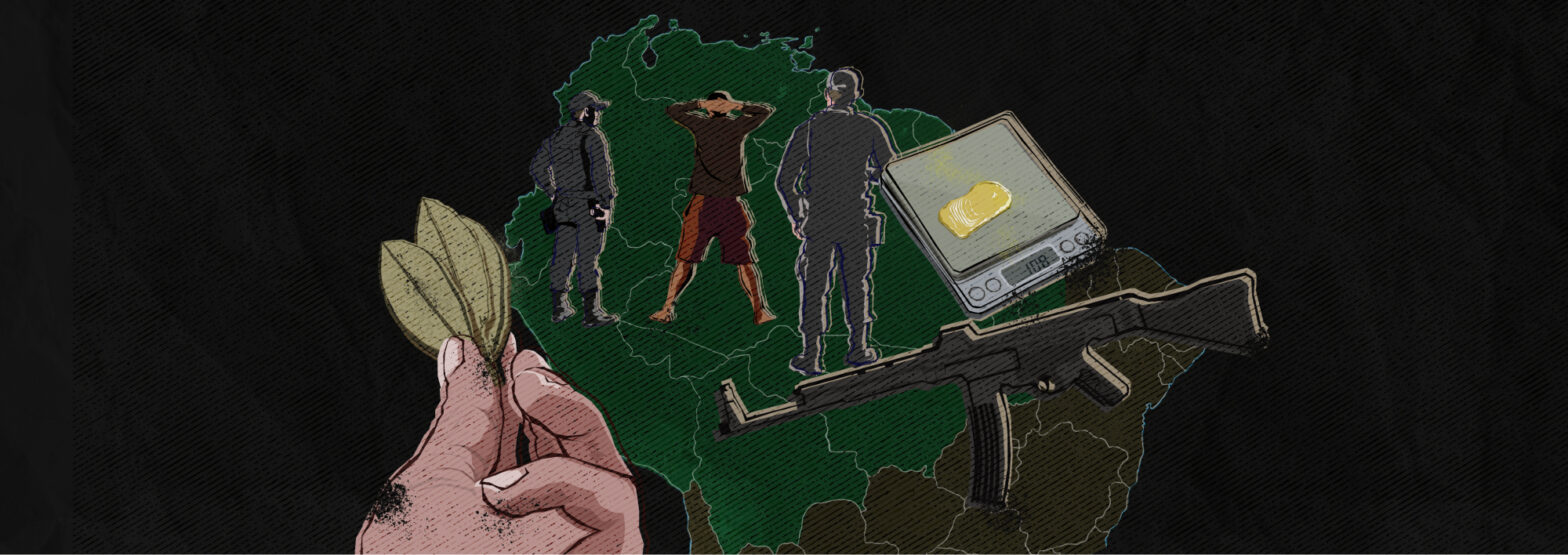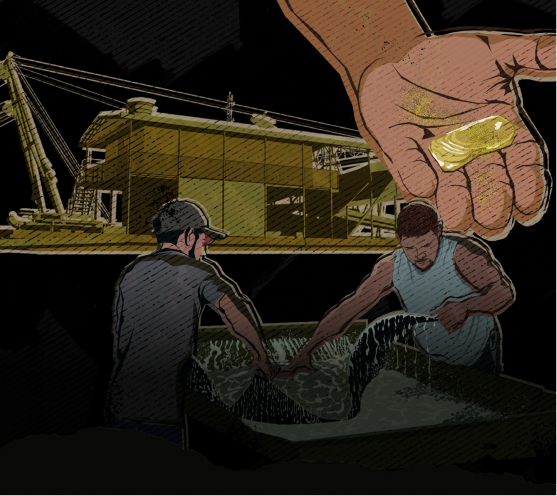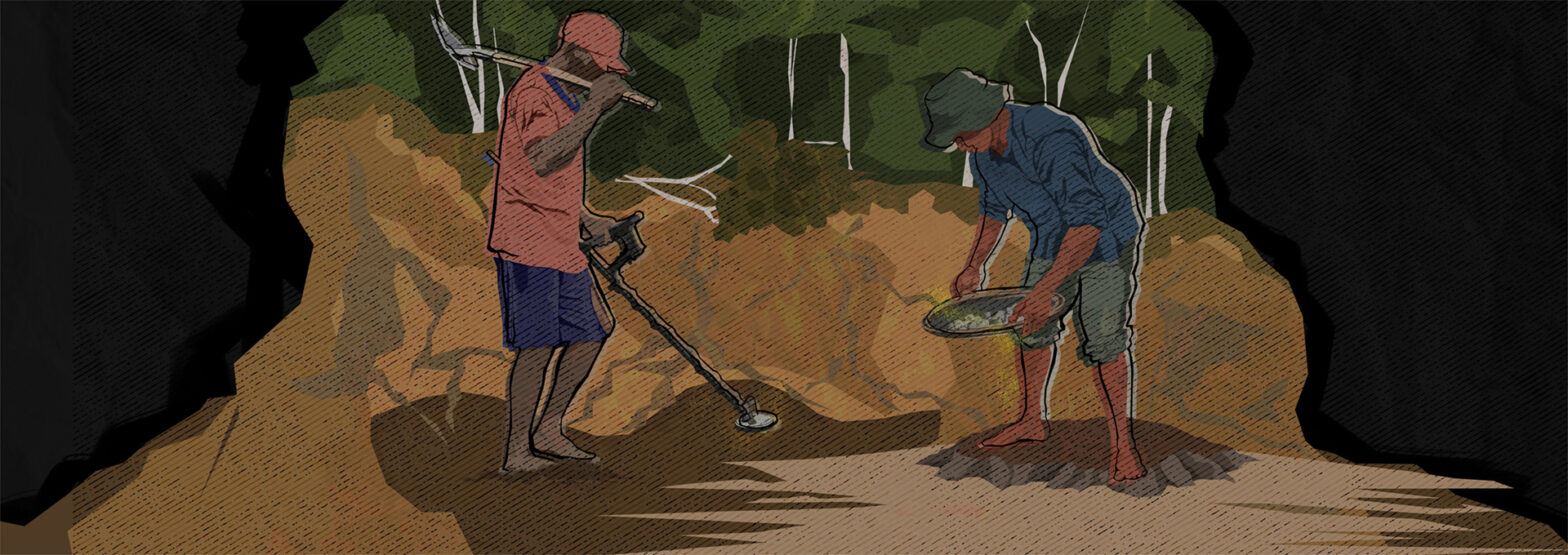Satellite images show that the interruption of gold mining immediately changed the color of the river. Operators of dredges, which can cost up to US$1.4 million, said they planned to return to the area after the government anti-mining operation ended.
A joint operation in recent days along remote rivers in the Brazilian state of Amazonas, near the border with Colombia, resulted in the burning of at least 29 dredges. Videos circulating in miners’ WhatsApp groups showed equipment in flames. One source said explosives were used to disable the barges.
Amazon Underworld was in the area in February of this year and counted more than 80 dredges along a 226-kilometer (140-mile) stretch of the of the 394-kilometer (245-mile) Puruê River.
The crackdown, called Operation Agata-Uiara Joint Command, involves the the armed forces, the federal environmental agency IBAMA, the Indigenous affairs agency FUNAI, and other government agencies. It is targeting the Juami and Puruê rivers. A team of reporters from Amazon Underworld—an alliance of InfoAmazonia, the Liga Contra el Silencio (Colombia) and Armando.Info (Venezuela)—that was in the area in February of this year counted more than 80 dredges along a 226-kilometer (140-mile) stretch of the of the 394-kilometer (245-mile) Puruê River, between the Japurá River and the community of Purezinho, a tiny mining settlement consisting mainly of simple wooden houses and two floating brothels known as “love boats.”
At the time, miners, government officials and a people connected with gold trafficking in Japurá estimated that there were about 150 dredges operating along the Puruê and its tributary streams and another 150 along the nearby Juami River, which flows through the Juami-Japurá Ecological Station, a federally protected conservation area. That would mean that this month’s raid burned barely 10% of the number of dredges that had been operating in the area.
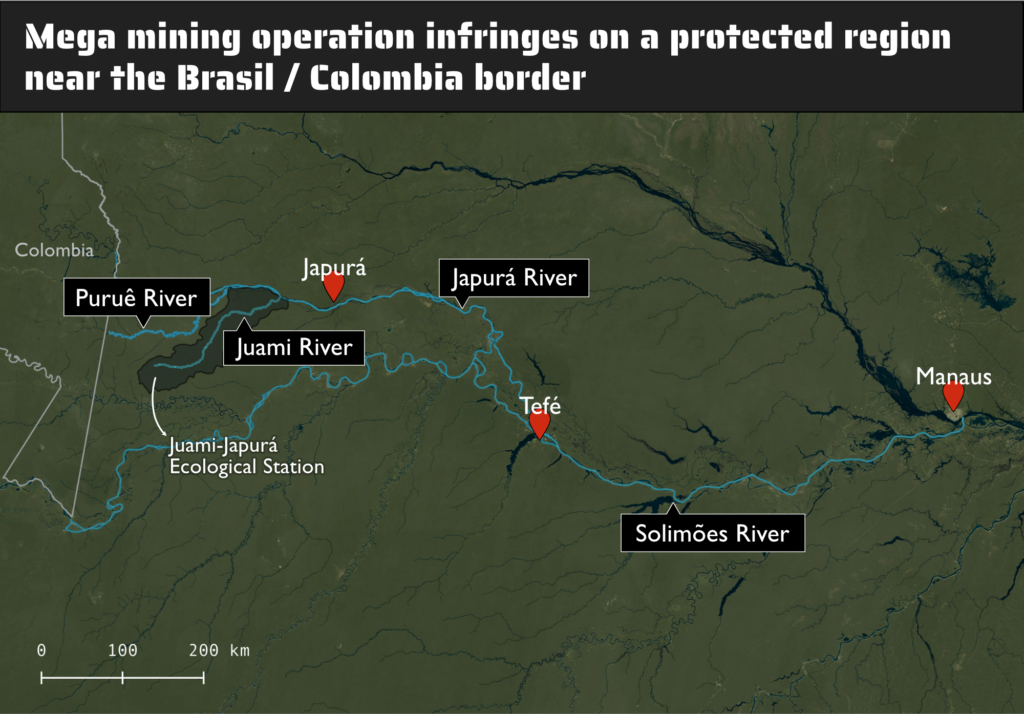
Dredges are hidden in the forest until the dust settles
That could be because despite the huge multi-agency crackdown, many illegal miners, known as garimpeiros, left the river before security forces arrived, after rumors circulated about a possible government raid in the area. At least one miner said he was spooked by seeing a small plane flying over the area. In response, some miners moved their dredges or tried to conceal them amid dense vegetation in nearby streams or lakes.
Another miner left for Tefé, the region’s largest city, before the raid, when the owner of the dredge on which he was working decided to try to conceal it in a community along the river. The effort failed, however. “They [security forces] found it and burned it,” the miner said.
One video shows a miner throwing buckets of water at a burning dredge. In another, a speedboat full of law enforcement officials approaches a dredge as the person filming says, “It won’t be long before they get ours.”
Region is among the most violent in Amazonia
Because of the strong presence of illegal mining, the Japurá region is considered one of the most dangerous and violent in Amazonia, even by the local police.
Despite its remote location and the dangers of alluvial gold mining, the Puruê is a magnet for poor workers who have little formal education. Along the river, everything—from day labor to soft drinks and sex work—is priced in gold. That makes miners prey for pirates, especially on the long trip from the mining area to Japurá, the nearest town to the mining region, where miners stock up on supplies and sell their precious metal.
The Brazilian environmental agency IBAMA estimates that dredges can cost anywhere from about US$150,000 to around US$1.4 million to build. The agency also estimates that the 29 dredges that were destroyed could have produced as much as US$4.6 million in illegal gold a month. According to the Brazilian Navy, the operation has also resulted so far in the seizure of 7.3 kilos of mercury— a highly toxic substance used to extract gold, which seriously harms the environment— as well as weapons and ammunition.

Dredges also operate on the Colombian side of the border, in Puré National Park. Mining increased in that area after rangers abandoned the park in 2020 because of threats from a dissident group of the Revolutionary Armed Forces of Colombia (FARC).
The following year, the Brazilian Army staged an operation against FARC guerrillas who were extorting payments in gold from miners on the Brazil side of the border. The Colombians were running that racket as far away as the town of Japurá.
Satellite shows immediate effect of dredges’ departure
The dredges’ impact on the river is so violent that satellite images show how, in just a few days, the interruption of mining and the miners’ departure caused a rapid change in the color of the water. The image on the left, from May 3, shows the Puruê River the color of coffee with cream—café com leite, in Portuguese—because of the amount of sediment stirred up by the dredges. In the image on the right, from May 17, days before the operation started, the river is closer to its natural black color.
An image from May 3 (left) shows the Puruê River the color of coffee with cream because of sediment stirred up by the mining. On the right, an image from May 17, after miners had stopped operating
The mining dredges, called dragas in Spanish and Portuguese, that are used in this region are huge machines with an improvised appearance. Often built with multiple levels, the are also extremely powerful. The lower deck is usually filled with machinery, while the miner, workers and sometimes the miner’s family live on an upper deck, which may be equipped with comforts of city life like Wi-Fi and satellite TV.
Between the huge electricity generators, powerful motors and thousands of millions of gallons of water cascading over the giant sluices, the noise of the dredges is deafening. Giant hoses suck mud from the riverbed and send it cascading over a sluice, which separates out the fine, gold-bearing sediment. Miners mix that with mercury, which binds to the gold, forming a lump. They then heat the lump with a blowtorch to vaporize the mercury, leaving behind a chunk of gold.
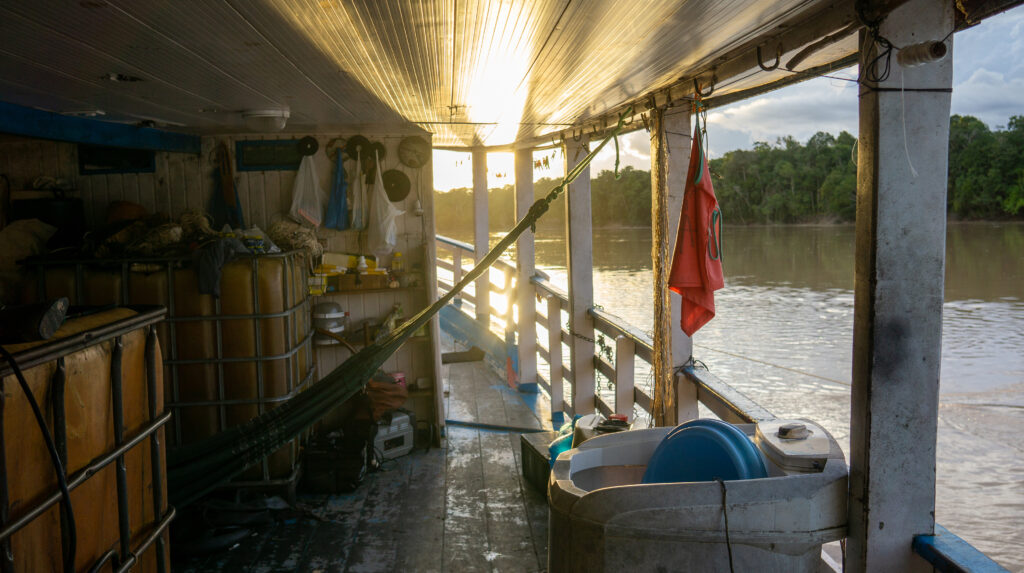
This kind of mining takes a heavy toll on the environment, filling rivers with silt, changing their course, and destroying or radically changing the habitat of aquatic creatures. Mercury, which causes neurological damage, is dumped into the river and accumulates up the food chain, especially in larger fish and the animals that eat them, including humans. The risk is especially great for Indigenous people and others living in riverine communities who depend on fish as their main source of protein.
Long-running cat-and-mouse game in Amazonia
The miners do their best to stay a step ahead of government security forces. In February, one garimpeiro who said he began working on the Puruê in the 1980s, when mining in the region was fairly new, described a decades-long cat-and-mouse game between illegal miners and law enforcement.
“I worked here 30 years ago, when the first dragas came,” he said. “I worked the first year, and then started working on other rivers, precisely because of persecution, because we were not legalized. When there was a raid, the police would shut down the mining site and we would move to another.”
Even the risk of losing a dredge in a raid does not discourage the miners, however. No other occupation—except possibly drug trafficking—offers the promise of such a high return, and a miner can recoup the cost of a destroyed dredge with a few months of illegal mining.
The miner who was waiting out the raid in Tefé said he would not give up on the illicit business, which paid him an average of 50 grams of gold a week—worth about US$2,800 at current prices at a gold shop in Japurá. Nevertheless, he was frustrated.
“This is really hard,” he said of the crackdown by security forces. “They only do this to miners. They don’t’ do anything to those guys who sell drugs. I spent seven years working as a locksmith and couldn’t even buy a piece of land. I went to work in mining, and in a year I bought a house.” Asked if he would return to mining, he said, “I don’t know, but I hope so. I want to finish my house.”
I spent seven years working as a locksmith and couldn’t even buy a piece of land. I went to work in mining, and in a year I bought a house
Miner waiting in Tefé to return to the region where the crackdown is taking place
Border hopping is escape strategy
If miners return to the Puruê, it will be at least partly because IBAMA lacks sufficient personnel to monitor the Amazon, Suely Araújo, former president of the agency and a specialist with the non-profit Climate Observatory, told InfoAmazonia. When the administration of President Lula da Silva took over from former President Jair Bolsonaro early this year, “It found the country’s environmental agencies in a scorched-earth situation, discredited and disorganized,” she said, adding that the new administration is committed to enforcing the law in the Amazon, but reorganization will take time.
“The country cannot be dominated by crime,” Araújo said. “The republic needs to be refounded in some parts of the Amazon territory that are suffering from a lack of [presence of] the state. They are, in fact, dominated by criminals.”
The republic needs to be refounded in some parts of the Amazon territory that are suffering from a lack of [presence of] the state. They are, in fact, dominated by criminals
Suely Araújo, former president of IBAMA and expert with the non-profit Climate Observatory
The narrow, winding Puruê River flows out of Colombia, where it is called the Puré. The fact that the river crosses the border complicates efforts to fight illegal mining, because when pursued by law enforcement on one side of the border, the dredges can escape fairly quickly and easily by crossing to the other country, where security forces from their country cannot operate.
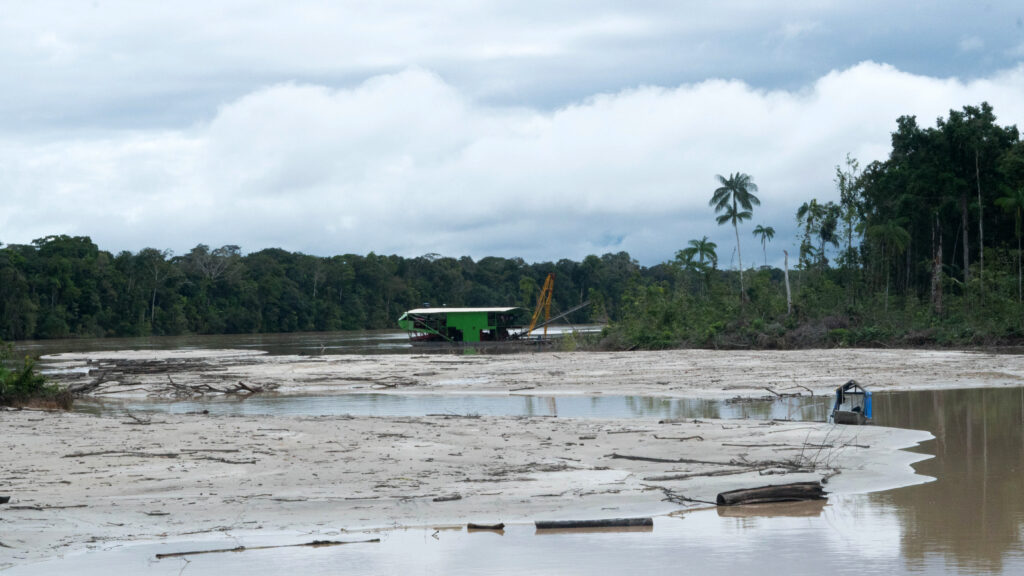
Dredges also operate on the Colombian side of the border, encroaching on Puré National Park and an area inhabited by semi-nomadic Indigenous people who shun contact with outsiders. Mining increased in that region after rangers abandoned the park in 2020 because of threats from a dissident group of the Revolutionary Armed Forces of Colombia (FARC).
In March 2022, Colombian armed forces destroyed two dredges, arrested three Brazilians and removed at least 12 dredges from the country, according to the Colombian Defense Ministry. But according to Colombian police sources interviewed for the story, also in 2022, during a helicopter overflight in preparation for an operation against the dredges, local authorities saw 10 operating dredges. The next day, however, all had crossed to Brazil to avoid Colombian security forces The same sources said that operations in the region are ineffective because they are not carried out jointly by the two countries.
Asked whether the operation currently under way was being coordinated with Colombian forces, the Ninth District Naval Command in the Brazilian state of Amazonas said only that the operation “has the goal of combating cross-border and environmental crimes, as well as intensifying the presence of the Brazilian state on the border It is coordinated by the Defense Ministry and executed by the Brazilian Navy, Brazilian Army and Brazilian Air Force in cooperation with federal, state and municipal entities and government agencies,” saying nothing about cooperation with the neighboring country.
This publication is part of the Amazon Underworld project, a joint investigation by InfoAmazonia (Brazil), La Liga Contra el Silencio (Colombia) and Armando.Info (Venezuela). The project’s goal is to map the activities of armed groups in the Amazon, and the full report will be published in July. The work is carried out in collaboration with the Pulitzer Center’s Rainforest Investigations Network and financed by the Open Society Foundation and the U.K. Foreign, Commonwealth & Development Office.


